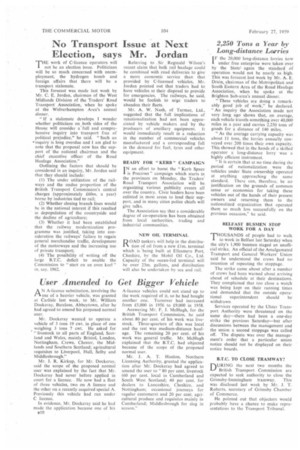User Amended to Get Bigger Vehicle
Page 44

If you've noticed an error in this article please click here to report it so we can fix it.
AN A-licence substitution, involving the use of a heavier vehicle, was granted at Carlisle last week, to Mr. William Dockeray, Barclose, Abbeytown, after he had agreed to amend his proposed normal user.
Mr. Dockeray wanted to operate a vehicle of 3 tons 19 cwt. in place of one weighing 3 tons 7 cwt. He asked for *
"livestock to all parts of England, Scotland and Wales, mainly Bristol, London, Nottingham, Crewe, Chester, the Midlands and Southern Scotland; agricultural requisites to Liverpool, Hull, Selby and Middlesbrough."
Mr. J. R. Kirkup, for Mr. Dockeray, said the scope of the proposed normal user was explained by the fact that Mr. Dockeray had never before applied in court for a licence. He now had a fleet of three vehicles, two on A licence and the other on a recently acquired special A. Previously this vehicle had run under C licence.
In evidence, Mr. Dockeray said he had made the application because one of his B10 A-licence vehicles could not stand up to the work required of it, so he had bought another one. Turnover had increased from £5,000 in 1956 to £9,000 in 1958.
Answering Mr. F. J. McHugh, for the British Transport Commission, he said about 80 per cent. of his work was livestock. Three-quarters of this was local and the rest was medium-distance haulage. The remaining 20 per cent. of his work was general traffic. Mr. McHugh explained that the B.T.C. had objected because of the scope of the proposed normal user.
Mr. J. A. T. Hanlon, Northern Licensing Authority, granted the application after Mr. Dockeray had agreed to amend the user to "80 per cent. livestock (60 per cent, local in Cumberland and South West Scotland; 40 per cent, for dealers to Lancashire, Cheshire, and Nottingham; occasional journeys for regular customers) and 20 per cent. agricultural produce and requisites mainly in Cumberland; Middlesbrough for slag in season."




































































































